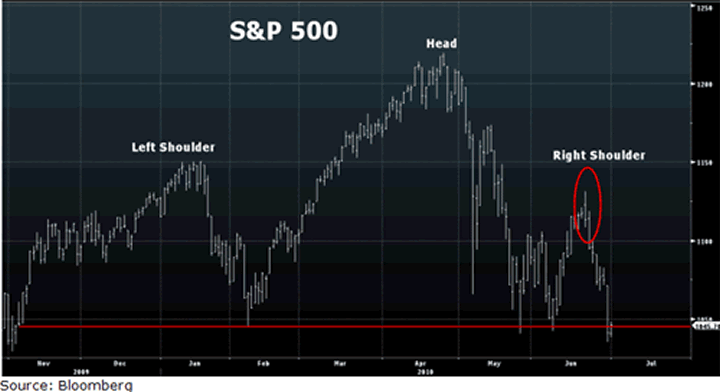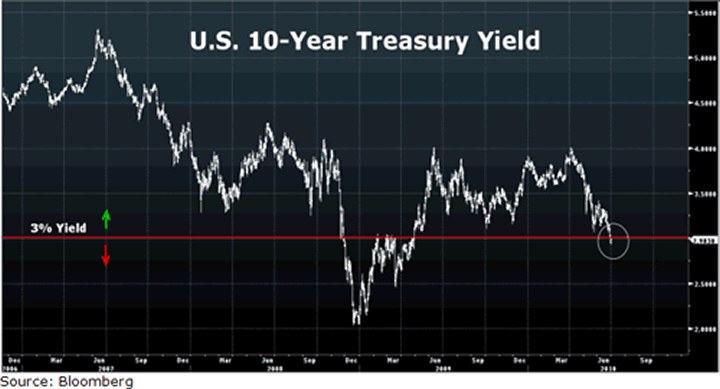Key Financial and Commodity Markets Pointing to More Economic Pain Ahead
Stock-Markets / Financial Markets 2010 Jul 03, 2010 - 10:15 AM GMTBy: Bryan_Rich
 In the past two weeks, we’ve seen China de-peg its currency from the dollar, the UK roll out historical fiscal austerity measures and Japan release details on a plan to tackle its massive debt load.
In the past two weeks, we’ve seen China de-peg its currency from the dollar, the UK roll out historical fiscal austerity measures and Japan release details on a plan to tackle its massive debt load.
The knee-jerk market reaction to these events was positive … i.e. interpreted as a positive influence on economic growth and a bullish cue for risk appetite.
In fact, for a few weeks in June the markets embraced all suggestions of fiscal consolidation after:
- Greece agreed to an aggressive austerity plan.
- The rest of Europe followed vowing to slash budget deficits.
- The UK announced its most severe tax hikes and spending cuts since the 1970s.
- Japan followed with a plan to balance its books and cut debt.
However, make no mistake about it, all that austerity is not coming by choice but rather by market forces. When Greek bond yields skyrocketed to more than 19 percent in May, countries with bloated debt and deficits were put on notice:
“Get your fiscal houses in order, or you will be shut out of the public bond markets.”
All the while U.S. stocks, perhaps the best proxy of expectations for global economic health, screamed higher, gaining nearly 10 percent in 10 days.
Then, the big piece of the puzzle the world had been waiting for: China. China announced that it would end its 2-year peg to the dollar and adopt a new exchange rate policy for its yuan — in other words, a yuan revaluation.
All Good Things for the Global Economy, Right? Well, Not Exactly …
China moved off of the dollar peg to a trading band based on a basket of currencies. While many think this was a concession from China to strengthen its currency against the dollar, I see it differently …
Perhaps China’s policy change indicates a concern for the global economy. And thus, it was a move to diversify China’s exchange rate risk. As an export-oriented economy, what is China’s exchange risk? Obviously, it’s a stronger yuan.
As I’ve said in past Money and Market columns, historically, financial crises tend to breed sovereign debt crises. And sovereign debt crises tend to lead to currency crises.
If China foresees the possibility of a growing sovereign debt crisis, global currency devaluations and perhaps even a break-up of the euro, it doesn’t want its currency pegged to the dollar … a currency that will likely continue to strengthen as the world’s safe haven currency.
China is an ardent defender of its export market. And a continued decline in the euro and potential fall of the currencies of its other trade partners makes China’s exports less affordable — when pegged to a strengthening U.S. dollar.
The following three key markets are good proxies for what we might see coming for global economic performance and risk appetite. Take a look at what they are projecting:
Proxy #1— Key Reversal Signal in Stocks
After retracing nearly 10 percent from its June low, the S&P 500 topped out on the day China announced its new currency policy. That marked a bearish outside day (circled in red in the chart below), a key technical reversal indicator.
Now the stock market has formed a head and shoulders pattern that suggests a move down to 860 … 24 percent lower than the peak level seen just two weeks ago.

Proxy #2— Ten Year Yields Below 3 Percent
While many market followers have been forecasting higher interest rates, the ten-year Treasury market is responding with the exact opposite.
As risks of sovereign debt problems rise and the probability of a double-dip recession for the world increases, global investors are continuing to pile into the U.S. Treasury market for safe haven. And that’s driven 10-year yields back below 3 percent.

Proxy #3— Commodities Breaking Down
Lastly, there’s a famous historical study on sovereign debt crises by Harvard professor Kenneth Rogoff and University of Maryland professor Carmen Reinhart that suggests sovereign defaults are typically triggered by a collapse in commodity prices.
So what are commodities telling us?
Well, for one thing, the second quarter has been the worst quarter in more than a year for commodities. The total return index of 24 raw materials plunged 10 percent since the end of March.
If the following chart of crude oil is any indication, commodities could be headed much lower.

This week the price of crude oil broke through trendline support. Moreover, the technical pattern suggests crude could fall to the mid-50s, at minimum.
To sum it up, the key barometers of stocks, interest rates and commodities are all pointing to lower levels. And from a big-picture standpoint, the combination of these signals should concern anyone who is not prepared to weather another economic and financial market storm.
Regards,
Bryan
Weiss and Weiss Research analysts offering the latest investing news and financial insights for the stock market, including tips and advice on investing in gold, energy and oil. Dr. Weiss is a leader in the fields of investing, interest rates, financial safety and economic forecasting. To view archives or subscribe, visit http://www.moneyandmarkets.com.
© 2005-2022 http://www.MarketOracle.co.uk - The Market Oracle is a FREE Daily Financial Markets Analysis & Forecasting online publication.



